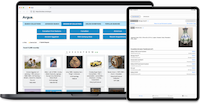Museum Collections Online: Learning Through Storytelling

Rachael Cristine Woody
Online collections can lead to fresh and creative approaches in how stories are told, making for more dynamic and accessible museum experiences compared to some traditional, physical displays. Moreover, when hosting an in-person exhibition becomes challenging due to space limitations, staffing issues, or other logistical obstacles, the ability to create a digital-first exhibit offers a viable alternative.
Whether your online collections are featured as part of a larger exhibition or function independently, it’s crucial to focus on the craft of storytelling to ensure its effectiveness across both digital and physical platforms.
This series will explore three key storytelling objectives from an exhibition standpoint, highlighting how to effectively use online collections to support or shape the narrative. The three focal points will be engagement, education, and reflection. Last week we reviewed digital collections and storytelling through the lens of museum visitor engagement. This post will focus on learning.
Storytelling Goal: Learning
Offering knowledge and lessons through storytelling is as old as the art of storytelling itself, and in general terms, sharing knowledge through stories is the primary point of storytelling as a craft. Of the three storytelling goals, learning is the most complex because we’re attempting to craft learning opportunities for a diverse range of ages, knowledge levels, and socio-cultural and economic backgrounds.
Learning as a storytelling goal requires the following pieces:
- An introduction and grounding in the topic
- Context to help the users connect themselves to the story
- Information offered on a sliding scale
- Demonstration of the concept (examples)
- Summarization to help cement learning
While each of these pieces seem obvious, they can be easy to overlook. It may also be difficult to adjudicate sufficient exhibit space to each piece, especially considering that we are attempting to convey information to a very broad range of people who may view the exhibit.
How to Achieve Learning through Collections Online Storytelling
Whether as part of an exhibit, or the entirety of an online exhibit, collections online can support viewer learning. The following pieces can be incorporated into an exhibition in the following way:
- An introduction and grounding in the topic: The introductory exhibit panel should convey the main story and help orient the user to the “need to know” information, such as the main topic and relevant time period (if applicable).
- Context to help the users connect themselves to the story: Our brains typically pay more attention once we understand how we fit into a particular narrative. Contextual information such as who, what, where, why, and when offer connection points that we can identify or empathize with. Before any learning can begin in earnest, we need to know how we can connect to the story and the lessons it may offer.
- Information offered on a sliding scale: Knowledge shared through the exhibit must be intellectually accessible to a very broad number of people. This can certainly be difficult to achieve, and the extra space offered by an online presence can help support different variations for different types of brains.
- A demonstration of the concept (examples): Examples are one of the best ways to impart information that will endure. This is especially true for intangible concepts that may be difficult to understand through reading text alone.
- A summarization to help cement learning: Much as an introduction is important to set the storytelling stage, so too is the conclusion. To help cement learning, a summary of the information and lessons learned wraps the concepts up into a completed package.
Create Learning Opportunities with Intentional Storytelling
When considering an online-only exhibit it can be easy to feel safe in the broad amount of online real estate you could use to tell your story. However, the challenge with so much space is that a story can become bloated or the lessons learned are too convoluted.
It’s important to remain intentional about the story you are telling, and thoughtfully incorporate learning elements in the narrative to support the goal—versus offering distractions.

Rachael Cristine Woody
Intrigued by this post? Please join us for the companion webinar, Storytelling Goals with Museum Collections Online, Wednesday, November 20, 2024 at 11 a.m. Pacific / 2 p.m. Eastern. (Can’t make it? Register anyway and we’ll send you the recording and slides when they’re ready). Register now or call 604-278-6717.
Never miss another post. Subscribe today!
Similar Posts
Museum Forecast 2026: Federal Policy, Revenue Pressure, and the Role of Professional Organizations
In her 7th annual Museum Forecast, Rachael Woody reveals her predictions, hopes, and concerns for the museum industry in 2026.
From Preservation to Resilience: An Introduction to Building Resilient Digital Collections
Preserving a digital collection is a job that is never done. But what if we shifted our focus from preservation to building digital resilience?
Client Spotlight: MacLaren Art Centre Goes Beyond Collections Care to Access and Growth
“As our needs evolved, it became clear that our existing CMS was no longer working for us. Not only do we need to perform basic collections care, we need a system that will support public access, enable growth, and match our innovative strategies.”
Museum Collections Online: Digital Storytelling Blog Series Roundup
An overview of 10 blog post series that highlight how museums can leverage online collections and digital storytelling platforms, strategies, tools, and best practices.





Leave a Comment
Comments are reviewed and must adhere to our comments policy.
0 Comments